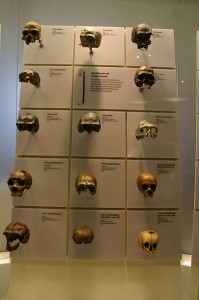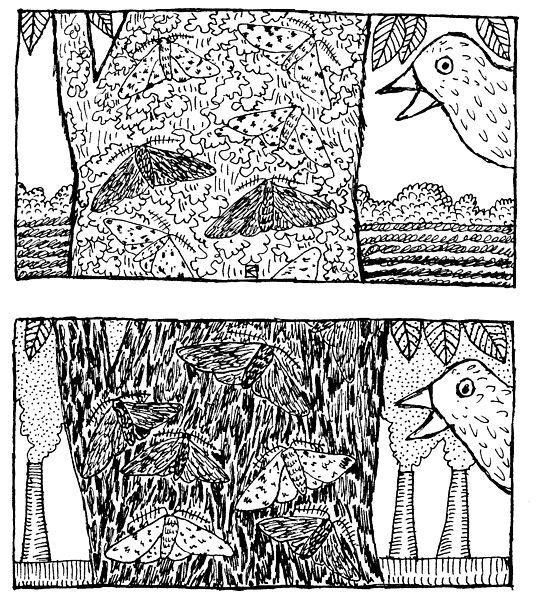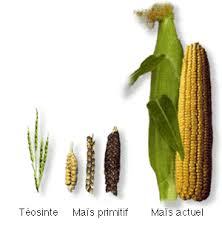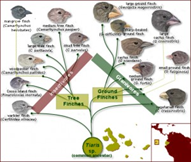The evidence for evolution is abundant in size and vast in scope, consisting of lines of inquiry from multiple fields converging on this single great insight. With that said, the rich evidence available in the fossil record would be sufficient to prove that the evolution of species has occurred. Although the fossil evidence alone would fill many volumes, I will attempt to summarize and outline the main lines of evidence here. As good as any place to begin, I suppose, is the fossil record.

- The fossil record – Sometimes when a plant or animal dies its hardened remains can be preserved or fossilized through a variety of physical and chemical processes. These hardened remains reveal the physical history of our ancestors and show clear linkages and intermediaries between past and present groups of species. Intermediaries between all kinds of groups of animals have been found such as between fishes and amphibians, reptiles and mammals, dinosaurs and birds, terrestrial mammals and whales, human and chimpanzee, and so on. Many intermediaries were predicted *before* the actual fossils were found, showing the predictive power of evolution.
- Evidence from DNA – A process known as DNA sequencing, which determines the order of the nucleotides in a DNA molecule, can be used to compare the DNA of any two species. Modern evolutionary theory predicts that closely related species – those with a recent common ancestor such as humans and chimpanzee – should share a higher percentage of their DNA than more distantly related species – such as humans and frogs, or humans and pine trees – and guess what? They do.
- Artificial selection – Charles Darwin began On the Origin of Species with a section on artificial selection, which is similar to natural selection except that it is humans rather than nature selecting for particular traits. Auroch’s, the ancestors of some of our domesticated cattle, have been modified by repeatedly selecting for qualities such as their ability to produce milk, aggressive behavior, and so on. Corn was breed for size and calorie content and barely resembles its ancestor strains. Artificial selection is evident in the domestication of other plants such as wheat, rice, and various fruits and vegetables, and animals such as dogs, cats, sheep, goats and racehorses.
- Evolution observed in nature – Evolution is sometimes difficult to notice occurring in nature due to its slow, gradual process that requires a lengthy timespan of many generations. This is why its easier to observe in the lab by using bacteria or fruit fly’s which have shorter time spans compared to many other plants and animals, such as humans, red wood trees, and foxes. In any case, evolution has still been observed a few times nature. The classic textbook example is that of the peppered moth changing its color due to selection pressures from pollution during the Industrial Revolution in England. Other observations include: populations of flowers blooming earlier due to warming weather; insects evolving resistances to pesticides; and lactose tolerance (technically called lactase persistence), and the sickle-cell trait (a perfect example of natural selection given that the geographical distribution of the gene for hemoglobin S and the distribution of malaria in Africa virtually overlap). This leads us to…
- Geographic distribution of plants and animals – The observed snapshot of the characteristics of plants and animals fits what would be predicted by modern evolutionary theory. Populations of closely related species should resemble those in close proximity to each other and gradually become less similar as you move further away. While on his historic voyage aboard the HMS Beagle, Charles Darwin noticed that finches and tortoises on the Galapagos Islands resembled those on the South American mainland and concluded that “one species had been taken and modified for different ends.” This phenomenon is observed all of the world and is explained by the geographic speciation of plants and animals.
- Microevolution observed in the laboratory – Microevolution has been observed many times in the lab. A famous example is from the lab of Richard Lenski, an evolutionary biologist working at Michigan State University, that has been running a long term E. Coli evolution experiment since 1988 with a duration of longer than 60,000 generations that has shown evolution in action. The evolved resistance of DDT in fruit fly’s is another example.
- Vestiges in species – A vestige in biology is a part or organ of an organism that has become reduced or functionless in the course of evolution. The examples in nature of abundant. Whales have no hind legs but have tiny bones in them which are remnants of the hind legs of their walking ancestors from the distant past. Birds such as ostriches do not fly but have stubs of wings from their flying ancestors. Numerous species who now live in the dark have lost their eyes but still contain eye sockets. All mammals, including humans and the other tailless primates, have a tail at one point in their development. Humans have a tail for a period of about four weeks in our embryological development and we possess a tailbone when born, despite not having a tail. Along with a vestigial tail humans have a long list of vestiges. We still possess the genetic machinery to make our hairs raise when we’re cold (to trap in more heat) or when we’re afraid (to appear larger) even though we have lost most of our hair. We call this goosebumps.
This list barely scratches the surface of the evidence for evolution but provides a good place to start. The evidence for evolution is extremely vast and conclusively proves evolution as a fact. Knowing that evolution is a fact, we can now look at why understanding evolution is important.
Further reading: The Greatest Show on Earth by Richard Dawkins; Climbing Mount Probable by Richard Dawkins; The Blind Watchmaker by Richard Dawkins; Human Natures by Paul Ehrlich



I 1000% believe in evolution! I mean, it’s just common sense! I also find it insanely fascinating!!!
It’s not really something I had ever thought about before, but it is vastly important and interesting. I need to read more into it.
There is so much to support the idea of evolution. Things are always changing, even if it is gradual. We had year passes to the Museum of Natural Science in Houston last year and it was fun to see all of the artifacts, fossils, and evidence in all of that. Even my young boys noticed the changes in a few of the displays.
I find it very interesting and it fascinates me every time I heard and read about evolution. The theory of evolution is a fact and I am a believer. Thanks for sharing this wonderful article
I love reading about evolution! It’s crazy to me that some don’t believe in it
I love reading about evolution! There is so much evidence to back it!
I took microbiology last semester and was amazed at how microbes, viruses, and so many other things are always evolving.
I love that we are continuously discovering things about our world and how it has changed. Very interesting view point.
It is amazing to me, in this day and age, that people don’t believe in the truth of evolution. Granted, there are still people out there who truly believe the earth is flat… so there’s that.
It’s nice to believe we are always evolving. I would hate to think that we could not adapt to the changes in our world.
Nice little project here. I feel like my brain got a little stronger…… not long from now we gonna be cyborging & that too is a kind of evolution.
Life….What a trip!
I love reading through this site, I come out more educated than I came in. I agree in evolution but to a certain extent though. It is a complicated topic
Great topic! To think that one type of organism could descend from another type is mind blowing and interesting.
This was so interesting read. It’s hard to believe there are people out who don’t believe in evolution x
Laura
https://pinkfrenzymissl.blogspot.com/
I’ve always been fascinated by science and I agree with you, the scientific proof of evolution is abundant. It is so unfortunate that some people prefer to look the other way. Great post.
I do not depend on evidence outside the Bible to strengthen my faith. You would say it makes sense that we have evolved. I would say it makes sense and answers every question that a God exists.
The Bible is a very unreliable source of evidence, especially when it comes to biology.
I never really pay attention to evolution before but there are some interesting facts presented in this post.
I think as technology advances, we’re able to see clearly about our origin. One of which is the evolution of humanity.